Acer Aspire V3-571G-9435: The Value Proposition
by Jarred Walton on July 4, 2012 4:25 AM ESTAcer V3-571G General Performance
We start as usual with our general performance application benchmarks. We still don’t have quite as many laptops available in our updated Mobile Benchmark Suite as we’d like, and there’s not much point in comparing a full-size notebook with several different models of Ultrabook. We’ve tried to stick with the more meaningful comparisons where possible, but we also wanted to flesh out the charts with additional data points. The result is the following selection of laptops, with their basic specs listed in the table, and as always, should you want to make additional comparisons, head over to Mobile Bench.
| Laptop Configuration Overview | ||||
| Laptop | CPU | Graphics | Storage | Battery |
| Acer Aspire V3-571G | Intel i7-3610QM | GT640M/HD4000 | HDD | 48Wh |
| Acer TimelineU M3 | Intel i7-2637M | GT640M/HD3000 | SSD | 55Wh |
| AMD Trinity Prototype | AMD A10-4600M | HD7660G | SSD | 56Wh |
| ASUS N56VM (Prerelease) | Intel i7-3720QM | GT630M/HD4000 | HDD | 56Wh |
| ASUS Zenbook Prime UX21A | Intel i7-3517U | HD4000 | SSD | 35Wh |
| ASUS G74SX-A2 | Intel i7-2630QM | GTX560M/HD3000 | SSD | 90Wh |
| Clevo W110ER | Intel i7-3720QM | GT650M/HD4000 | Hybrid | 62Wh |
| Razer Blade | Intel i7-2640M | GT555M/HD3000 | SSD | 60Wh |
| Sony VAIO SE | Intel i7-2640M | HD6630M/HD3000 | HDD | 49Wh |
| Toshiba P755D | AMD A8-3520M | HD6620G | HDD | 47Wh |
As we’re starting with PCMark results, we again want to note how much of an impact the presence of an SSD has on the results. It makes most of the comparisons between the HDD and SSD equipped laptops meaningless, but it does serve to drive home the point that for some workloads an SSD will make a huge difference. I switched over to a 240GB SSD for my laptop and Ultrabook use, and whenever I have to use and test a laptop that only has HDD storage (like the Acer V3), the difference is painfully obvious.
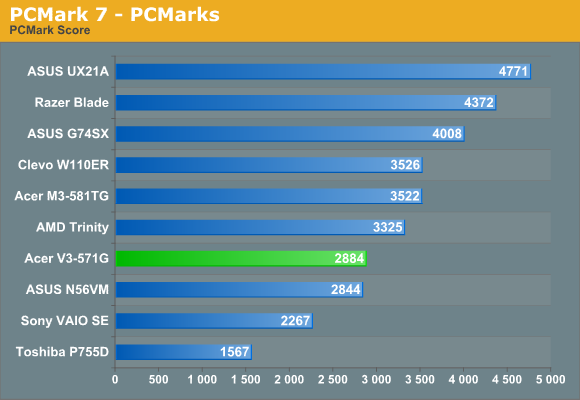
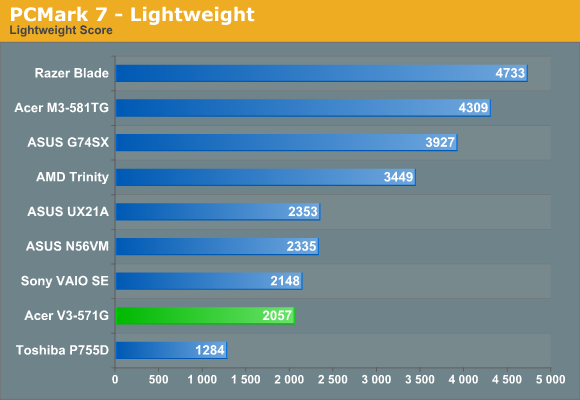
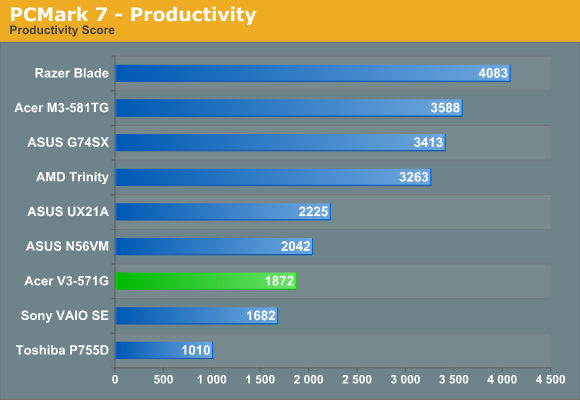
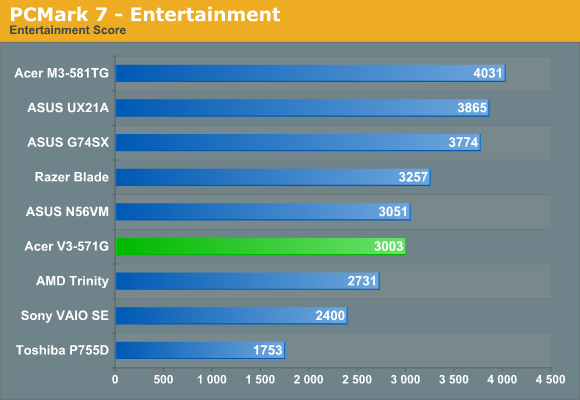
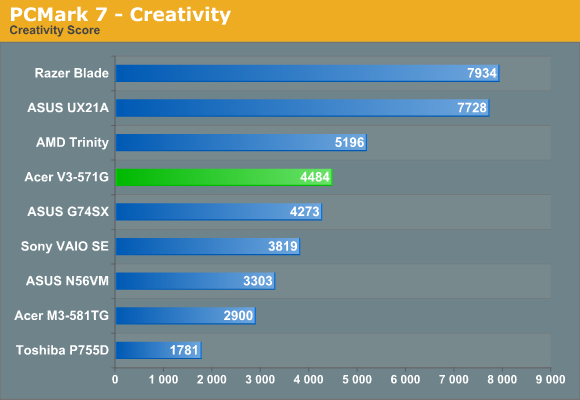
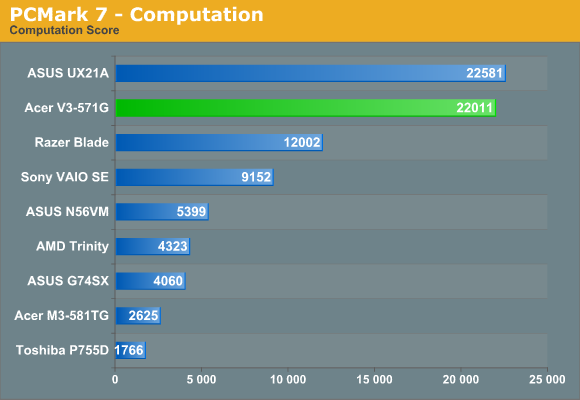
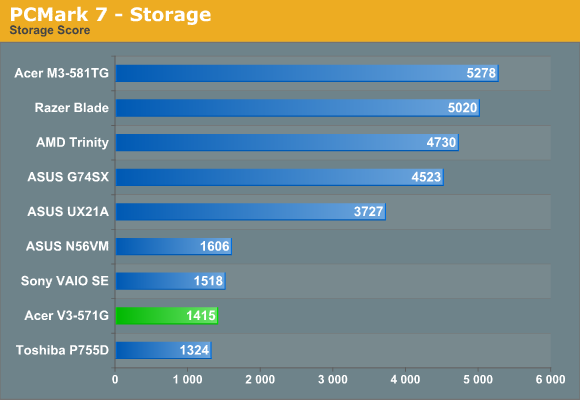
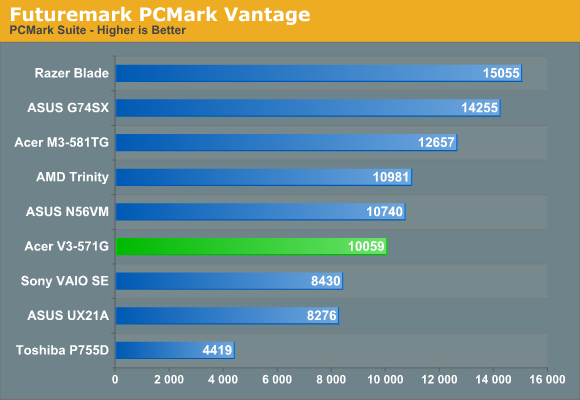
The placement of the Acer V3 in the above charts isn’t very inspiring, but remember what we said about SSDs. Most of the higher scoring laptops feature SSDs and/or slightly faster CPUs. For general use, any of the laptops will be “fast enough”, and as long as you don’t mind waiting during intense periods of disk activity (e.g. initial boot up of the OS and various applications) even the HDD equipped laptops will work well. Still, one look at what an SSD does for the ASUS N56VM might make you consider splurging on better storage system. Acer adds insult to injury here by going with a 5400RPM hard drive, and the only slower Storage score in the charts comes from the Toshiba P755D—which also uses a 5400RPM Toshiba hard drive, not surprisingly.
If we look at the one PCMark 7 test that doesn’t hit storage at all, the Computation suite, we run into a different problem. Here, all of the laptops that support Intel’s Quick Sync technology get a massive performance boost, and the Ivy Bridge processors are basically twice as fast with Quick Sync as Sandy Bridge parts. It makes for yet another lopsided graph, which makes the overall usefulness of the PCMark scores debatable. As long as we understand what the charts represent, however, we can at least use them to gauge relative performance. The basic summary is that, for general use, a moderate CPU (e.g. Trinity, Llano, or Sandy Bridge) with an SSD will offer a better experience than just about any current HDD-based laptop; similarly, if you want to do hardware accelerated video encoding, there’s no beating Quick Sync.

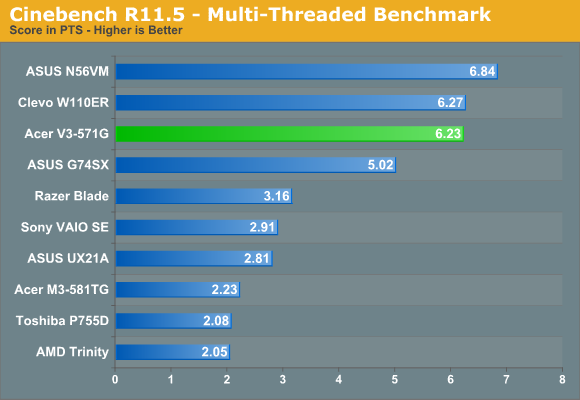
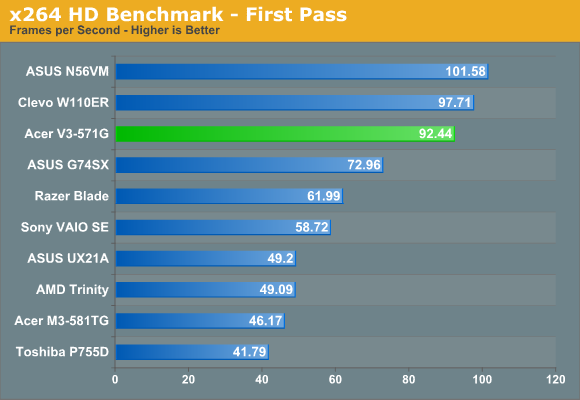
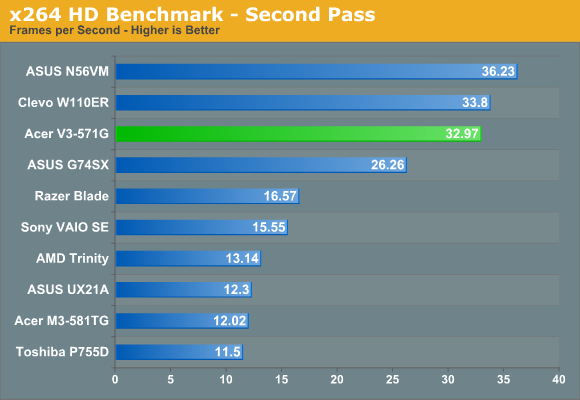
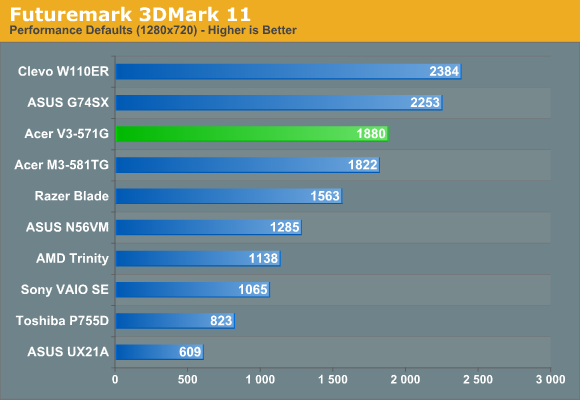
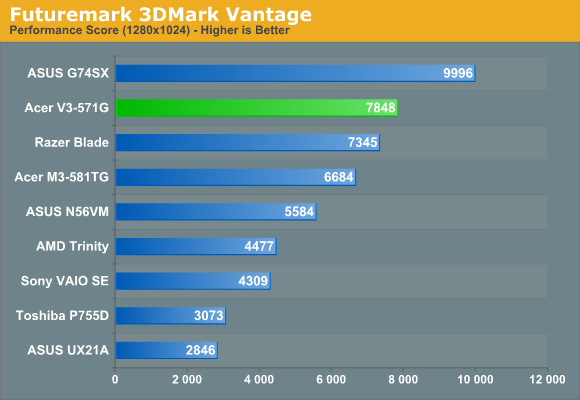
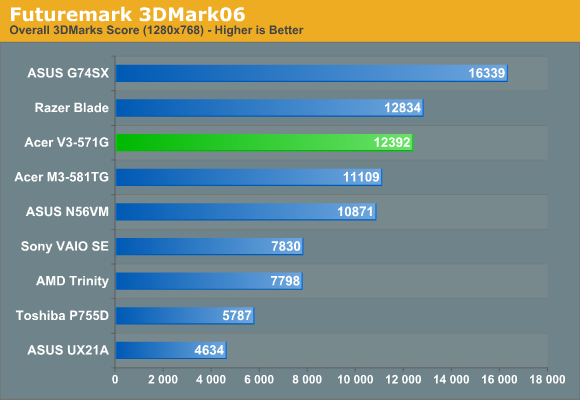
When we shift over to our more CPU- and GPU-centric tests, the performance results start to look more sensible. As one of two quad-core Ivy Bridge laptops, the Acer V3-571G takes second place in all four of our CPU-based tests, losing out by a small margin to the higher clocked i7-3720QM in the ASUS N56VM. The 3DMark scores tell a similar story, although this time it’s the GTX 560M in the ASUS G74SX that takes first place, with the GT 640M generally falling into second place and trading blows with the Razer Blade and Acer M3-581TG Ultrabook. The latter has the same GPU but a slower ULV Sandy Bridge processor, and we should hopefully have the updated M5 Ivy Bridge model in for testing in the near future.










88 Comments
View All Comments
StormyParis - Wednesday, July 4, 2012 - link
It's an article of faith among tech reviewers that SSDs are where it's at nowadays. I have doubts:1- Size: especially on a laptop, I'd rather have a large HD on which I can stick a few games, 10+ hours of films for me and the kids. AN SSDs pretty much means you *have* to carry an external HD. Or read getting bored.
2- Reliability: the only reliability survey I ever saw says SSDs fail on average almost twice as much as HDDs.
3- limited use case: very few apps do a lot of disk I/O once launched, and 4GB systems mostly don't swap, so SSDs are mostly useful during boot and app launch. Also, many users now do sleep/hibernation with apps open, instead of a full reboot + apps relaunch. That makes for a scarce few seconds when the SSD will be felt.
I'm fairly sure reviewers aren't needing hours of videos during their reviews (they're at work, not snowed in with the kids ^^), do full startups (and few of those), and are given somewhat pre-tested units. Isn't there a big disconnected between reviews and users ?
Omoronovo - Wednesday, July 4, 2012 - link
1. For a laptop, you're unlikely to have many games installed that are dedicated, hardcore games that take up 25GB of space each. Diablo 3 et al are all relatively large games, certainly, but you will know which ones will be playable on a machine like this and you will be clever enough to plan accordingly. As for movies, having anything higher than 720p on a machine with this resolution is pointless; and even at maximum quality (again, ruined on a panel of this quality, but for arguments sake), you're talking about 40GB of movies for 10 hours of potential playback. A 128GB ssd would be enough to cater to both of these with space to spare.2. Unless you can cite your source for this survey, we can't really comment on its validity. Solid state drives have come a long way; I have no doubt that drives like my first generation Indilinx-based SSD have higher failure rates, but that's the price for early adoption. They are far, far more reliable now, with Sandforce being able to de-dupe and compress data so that only a fraction of nand is physically written to (whereas early Indilinx based drives had insane write amplification, wearing nand far faster than necessary for the sake of performance).
3. SSD's make a tangible "snappiness" improvement to your machine. This is especially noticeable with Windows due to the way it prioritizes data in ram. Take a theoretical example: Opening control panel. On a standard disk based system, each and every file called needs to be accessed from disk; excluding those files already loaded (like the ui elements as those are shared with all standard explorer windows). If there are 30 files to access, with a standard disk you will have as much as 450ms latency to get all of those files loaded into ram and the panel opened, not to mention any processing time (ordering of icons and such). This is only half a second, that is true. Scale this up with all file and folder access on the machine (from all programs, devices, and services, bearing in mind that when multiple programs try to access the disk (HDD) at once, the latency is exacerbated), and you quickly realize why using an SSD makes such a huge improvement to the day to day usability of a machine.
In my case, personally, I noticed far more of an upgrade in my day to day use of my machine when I upgraded to a SSD, than I did upgrading to a core i7-920 from a Core 2 duo E7200.
One final point I'd like to make: Although this laptop doesn't, there is nothing preventing a manufacturer dropping optical storage and using the space for a hybrid disk drive and SSD setup. When Windows 8 ships and OEM's start tearing into the Storage Spaces feature, "normal" people won't even have to go out of their way to move bulk data onto the disk drive, as windows will do it automatically and merge the SSD and HDD space into one contiguous area. Just something to think about.
Rollo_Thomasi - Thursday, July 5, 2012 - link
Even if the OEM:s usualy favors an ODD over a SSD HDD combo you can simply replace the ODD yourself.Here is an article on that:
http://www.extremetech.com/computing/131697-ivy-br...
Christopher29 - Wednesday, July 4, 2012 - link
1. Agreed, size still is not enough ...2. Completely untrue - see forum xtremesystems thread: SSD-Write-Endurance-25nm-Vs-34nm/page195 - where users intentionally try to wear out SSDs, most of them hold from 600TB - 800TB, and 256GB Samsung 830 holds 2,500TB Host writes. Everyone died after stating correct S.M.A.R.T warnings.
For your perspective, I have written 3,8TB of data on my SSD since 2009 and this is 1/200 (0,5%) of possible writes that this SSD will handle - in other words - this SSD will outlive two to three laptops in which it will be used.
3. You tottaly don't know (and probably used) anything what You've just written in this point.
piroroadkill - Wednesday, July 4, 2012 - link
What are you even talking about? You can get 256GB SSDs for a very reasonable price these days, job done.Less power use, less likely to die in the manner that is MOST caused by use in laptops - knocking the heads around...
I would say maybe you can't afford an SSD, but really, very recently the prices have come right down to the point where there's no reason not to have one..
jabber - Wednesday, July 4, 2012 - link
Yes I picked up a SATA2 120GB SSD for $100 a few weeks ago.Why SATA2 well as my laptop only runs SATA2 I felt it pointless to get a 500MBps capable SSD when it will only run at half that speed.
Oh and its cheaper. Anyway instead of the WD Black 320GB drive giving me 85MBps I now have an SSD giving me around 275MBps. Big improvement especially in access times.
zorxd - Wednesday, July 4, 2012 - link
$780 is a high end laptop. Most people by laptops cheaper than that. This review sounds like the review of a BMW by a Ferrari owner, saying that the BMW is OK if don't care about cheap build quality and bad performance.zorxd - Wednesday, July 4, 2012 - link
The average selling price of a windows laptop was $513 in the US in February 2012.JarredWalton - Wednesday, July 4, 2012 - link
Where exactly does that stat come from, and what happens if you remove netbook class hardware from the list? Netbooks (and ultraportables like the 11.6" stuff with Brazos) are very inexpensive, but if people want to complain about this Acer's quality they should be even more harsh on such laptops. Regardless, $780 is hardly high-end for a laptop; it's at most lower-midrange pricing.zorxd - Wednesday, July 4, 2012 - link
http://blog.laptopmag.com/the-average-pc-laptop-co...netbooks or not, $780 is still much more than the average price for a laptop.
And this is only in the US, a rich country. The average of the world is probably much lower.